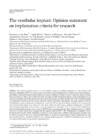Identificador persistente para citar o vincular este elemento:
https://accedacris.ulpgc.es/jspui/handle/10553/106474
| Título: | The vestibular implant: Opinion statement on implantation criteria for research | Autores/as: | van de Berg, Raymond Ramos Macías, Ángel Manuel van Rompaey, Vincent Bisdorff, Alexandre Perez-Fornos, Angelica Rubinstein, Jay T. Phillips, James O. Strupp, Michael Della Santina, Charles C. Guinand, Nils |
Clasificación UNESCO: | 32 Ciencias médicas 3314 Tecnología médica |
Palabras clave: | VOR Vestibular implant Bilateral vestibular areflexia Bilateral vestibular hypofunction Bilateral vestibular loss, et al. |
Fecha de publicación: | 2020 | Publicación seriada: | Journal of Vestibular Research: Equilibrium and Orientation | Resumen: | This opinion statement proposes a set of candidacy criteria for vestibular implantation of adult patients with bilateral vestibulopathy (BVP) in a research setting. The criteria include disabling chronic symptoms like postural imbalance, unsteadiness of gait and/or head movement-induced oscillopsia, combined with objective signs of reduced or absent vestibular function in both ears. These signs include abnormal test results recorded during head impulses (video head impulse test or scleral coil technique), bithermal caloric testing and rotatory chair testing (sinusoidal stimulation of 0.1 Hz). Vestibular implant (VI) implantation criteria are not the same as diagnostic criteria for bilateral vestibulopathy. The major difference between VI-implantation criteria and the approved diagnostic criteria for BVP are that all included vestibular tests of semicircular canal function (head impulse test, caloric test, and rotatory chair test) need to show significant impairments of vestibular function in the implantation criteria. For this, a two-step paradigm was developed. First, at least one of the vestibular tests needs to fulfill stringent criteria, close to those for BVP. If this is applicable, then the other vestibular tests have to fulfill a second set of criteria which are less stringent than the original criteria for BVP. If the VI-implantation is intended to excite the utricle and/or saccule (otolith stimulation), responses to cervical and ocular vestibular evoked myogenic potentials must be absent in addition to the above mentioned abnormalities of semicircular canal function. Finally, requirements for safe and potentially effective stimulation should be met, including implanting patients with BVP of peripheral origin only, and assessing possible medical and psychiatric contraindications. | URI: | https://accedacris.ulpgc.es/handle/10553/106474 | ISSN: | 0957-4271 | DOI: | 10.3233/VES-200701 | Fuente: | Journal of Vestibular Research: Equilibrium and Orientation [ISSN 0957-4271], v. 30(3), p. 213-223 (Julio 2020) |
| Colección: | Artículos |
Citas de WEB OF SCIENCETM
Citations
34
actualizado el 08-jun-2025
Visitas
224
actualizado el 27-sep-2025
Descargas
565
actualizado el 27-sep-2025
Google ScholarTM
Verifica
Altmetric
Comparte
Exporta metadatos
Los elementos en ULPGC accedaCRIS están protegidos por derechos de autor con todos los derechos reservados, a menos que se indique lo contrario.
